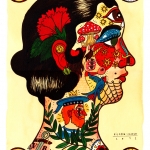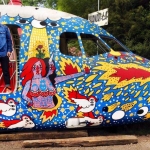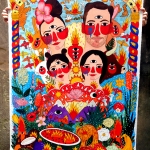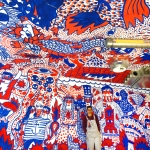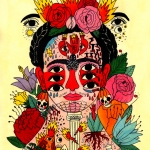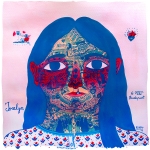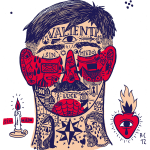It’s said that the eyes are the windows to the soul, sharing a person’s true nature they may otherwise keep concealed. Through those tiny peepholes escape internal hopes, dreams, loss and fervor. For illustrator Ricardo Cavolo, the eyes serve as the centerpiece of any story, reflecting the power and insight of the embodied souls and giving way to the future.
Cavolo is equal parts artist and storyteller, weaving intricate narratives with detailed brush strokes and vibrant colors attracting emotions from curious glances. Each of Cavolo’s portraits are smeared with personality, emphasizing not only his keen storytelling but the astuteness and depth with which he creates personas.
His portfolio speaks volumes of his abilities with a brush, ranging from paper to murals to the sides of swift moving trains. Cavolo-touched facades attract thousands of eyes in cities worldwide—you can find his large-scale work all over Europe, North America and the United Kingdom.
Much more than esoteric, his work engages the masses, as most well-told stories do. With an inherent Spanish influence and particular attention to colors and moods, Cavolo’s portraits and murals tell an amazing story of the artist’s character as well—the passion, the bravery and the driving imagination.
Give us the abbreviated Ricardo Cavolo bio. Who are you? Where are you from? What do you do? Why do you do it?
I am Ricardo Cavolo and I paint and draw as a lifestyle and as my job. I was born in my father’s painting studio (in Salamanca, Spain), so since then I have always been surrounded of brushes, canvases, colors, pencils. When I was a little kid and I started to be able to handle a pencil in my hand I realized that my favorite game was just to draw and paint the stories I had on my mind, and I have been doing that since then. The only difference is until 6 years ago I did it just for fun and now it is for fun and as my job as well.
How has your background influenced your artistic style?
I think my background has influenced my artistic style 100%. In fact, my artistic style is the final result of so many years feeding that background, and I understood that creating something pure and sincere was just to open my chest and show my background’s universe to the people. Of course nobody is born with a bunch of ideas already in their head, we are absorbing thousands of inputs. The secret of doing something personal and sort of unique is in the way you mix all those inputs and the way you explain it to the world.
Tell us about the politics within some of your pieces. What are you articulating through your powerful subjects?
Before the illustration I have the script/story in my mind. I use illustration for telling stories, and as I am a terrible writer, I try to tell it through my drawings. So once I have that story in my mind, I use a medium to articulate it—this medium is usually a portrait, someone, maybe the protagonist of the story—and I place the different details from the story in the “landscape- portrait.” I get two things out of this: I tell the story showing different details from it, and at the same time I get a powerful image—sometimes weird, or magical, or mysterious, a powerful vision. I like to give something to the spectators, paying them for their attention to my work, so I try to give a good vision, and at the same time a story that they can even continue to think about when they have left the illustration. It’s a game.
We see a lot of faces in your pieces, never the same and with such detail. What about faces do you like to illustrate or represent?
As I said, I always try to create portraits for something further, not just for showing an anatomical point of view of a face. The very same face is a portrait of the soul. But it is true I try always to pick portraits with some special physical details. As I can choose the person, or even better invent it, I want to generate something easier to remember. A face with some details you would remember if a couple of days later—you want to think of that person again.
The hero of a story is always created with some special details so you can remember his image.
Why so many eyes in your pieces? Are they more than figurative windows to the soul?
There were two reasons to drawing so many eyes on people. I want to speak about not regular people, but someone special and different form the average. I love to use symbolic details and I thought that with more than two eyes the person becomes different from the rest. And at the same time, as they are heroes in my stories, a hero is wise and intelligent, and I thought that the more you see, the more you know, the wiser. So more eyes, means you are able to see more than normal.
Where do you find the inspiration for your color palettes?
I love the sense of color from tribal arts. This style is very well connected with the natural or biological relationship between colors and humans. We perceive colors not just as light, but we translate those colors in feelings. I want to give a positive and optimistic feeling to the people looking at my work, so I use those strong warm colors. It’s like giving a warm hug. And also I like to use big contrasts and a powerful palette of colors to give some kind of “extra strength” to people. You perceive those colors working together and it’s as if you’re drinking a strength potion to be stronger.
Trains, planes, walls, paper—you’ve had a number of different “canvases.” What do you most like to work on and how does your process differ per different “canvas.”
Yeah, I love to change canvases because each one is a different challenge. The most used canvas for now it is a piece of paper in my studio. That is the classic one and I love and need it. But when I discovered the murals I found a universe that I really love. It’s magical, because it is like I get inside of the drawing. And the mural is a physical work, and painting so big is so fun and enjoyable. But even the best part is at the end, when it’s done. You see that big piece in a wall and it is a wonderful experience. You feel like a small worlds creator. And one of the best things is you are working for so much people they are going to see that mural everyday. You are trying to make a big present for all of them.
Regarding the process, of course it changes depending on the canvas but I don’t change the way of creating stories. I can work the same script in a small piece of paper than in a big wall, and that is why I feel so good working on different canvases. The process can be different but the roots are the same.
And how has working on such a range of projects—murals, prints, tarot cards, books, etc—shaped you as an artist?
For me it is perfect, and once you try to work on different kind of projects, you realize you need it. I hate to get bored, and one of the best ways for avoiding this is working on different kind of projects. Every one of these has different tricks, and positive points to use against another kind of project. I think it is about the challenge. If it is a challenge for me, I work 150% to do it as best I can, and I think this is seen in the final result of the project. People knows when the artist enjoyed the project and did his best.
What artists are currently inspiring you?
The outsider artist is my main source of inspiration. I think these people work as the most free artists in the world. Most of them they don’t care about what people will think about it, they don’t care about marketing, or about showing their feelings being totally sincere. That’s the key. In my opinion they are the most sincere artists, and sincerity and art have to be siamese twins, always together.
What music is currently inspiring you?
I always have a few musical planets in my life. The most visited planets would be primitive blues, country-folk and rap. Lately I go a lot to the rap planet, because it gives me a funny mood for work, and sometimes it gives me a naughty taste that I really enjoy for work. But I visit the two other planets daily as well.
For more from Ricardo, visit his site or follow him on Instagram
Originally published October 20, 2014.


